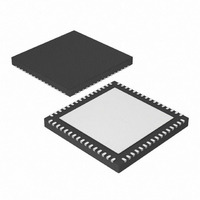DSPIC33FJ128GP706A-I/MR Microchip Technology, DSPIC33FJ128GP706A-I/MR Datasheet - Page 19

DSPIC33FJ128GP706A-I/MR
Manufacturer Part Number
DSPIC33FJ128GP706A-I/MR
Description
IC DSPIC MCU/DSP 128K 64-QFN
Manufacturer
Microchip Technology
Series
dsPIC™ 33Fr
Datasheets
1.MCP3909T-ISS.pdf
(104 pages)
2.DSPIC33FJ12GP201-ISO.pdf
(90 pages)
3.DSPIC33FJ64GP206-IPT.pdf
(28 pages)
4.DSPIC33FJ64GP206A-IMR.pdf
(338 pages)
Specifications of DSPIC33FJ128GP706A-I/MR
Core Processor
dsPIC
Core Size
16-Bit
Speed
40 MIPs
Connectivity
CAN, I²C, IrDA, LIN, SPI, UART/USART
Peripherals
AC'97, Brown-out Detect/Reset, DMA, I²S, POR, PWM, WDT
Number Of I /o
53
Program Memory Size
128KB (128K x 8)
Program Memory Type
FLASH
Ram Size
16K x 8
Voltage - Supply (vcc/vdd)
3 V ~ 3.6 V
Data Converters
A/D 18x10b/12b
Oscillator Type
Internal
Operating Temperature
-40°C ~ 85°C
Package / Case
64-VFQFN, Exposed Pad
Product
DSCs
Processor Series
DSPIC33F
Core
dsPIC
3rd Party Development Tools
52713-733, 52714-737, 53276-922, EWDSPIC
Development Tools By Supplier
PG164130, DV164035, DV244005, DV164005, PG164120, DM240001, DV164033
Core Frequency
40MHz
Core Supply Voltage
3.3V
Embedded Interface Type
I2C, SPI, UART
No. Of I/o's
53
Flash Memory Size
128KB
Supply Voltage Range
3V To 3.6V
Rohs Compliant
No
Lead Free Status / RoHS Status
Lead free / RoHS Compliant
Eeprom Size
-
Lead Free Status / Rohs Status
Lead free / RoHS Compliant
© 2009 Microchip Technology Inc.
2.2.1
The high precision class 0.2S requirement for the energy meter makes it crucial to
select proper burden resistors for the output of the current transformers.
Metal film resistors with low inherent noise and temperature coefficient are ideal. Given
that the secondary current of the CT is I, then the input voltage of the MCP3909 device
is U = IR, where R is the resistance of R
If the temperature varies by ΔT, and the temperature coefficient of sampling resistor R
is β ppm/°C, then the output voltage is:
EQUATION 2-1:
The voltage variation is:
EQUATION 2-2:
This relationship shows that the output voltage variation caused by temperature
variation is in proportion to the temperature coefficient of the burden resistor.
In addition, a smaller temperature coefficient benefits meter start stabilization after
startup. It takes a longer time for resistors with larger temperature coefficient to
stabilize. Therefore, accurate measurements would require a longer wait after
power-up. This affects the efficiency, or speed of meter calibration.
Burden Resistor Temperature Coefficient
ΔU
=
U' U
–
U'
=
=
I
×
I R
(
ΔT β
125
+
×
Δ
and R
Hardware Description
T
×
×
R
β
126
×
=
R
U
)
(Using Phase A as an example).
×
ΔT
×
β
DS51723A-page 19











